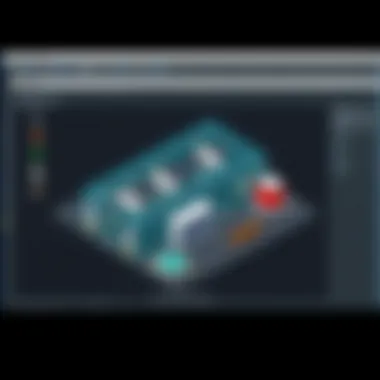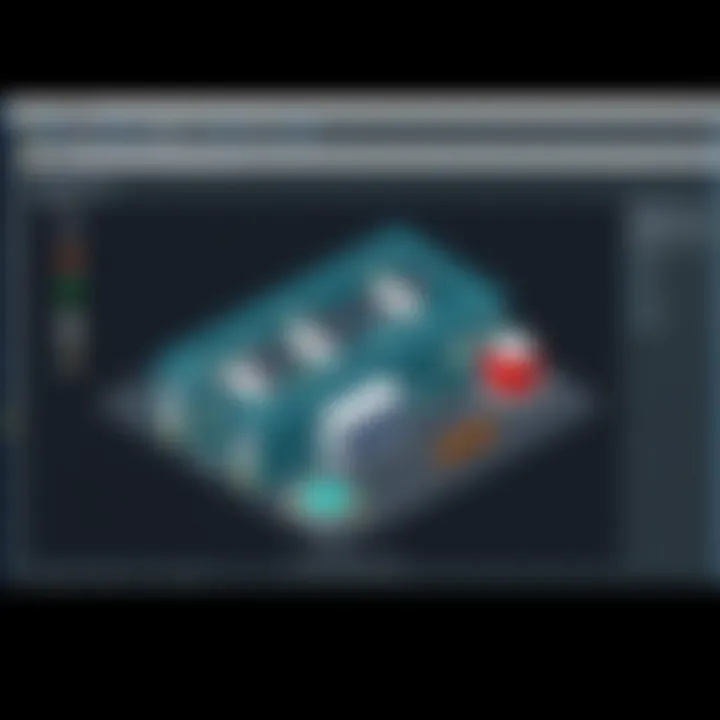Mastering 3D Modeling Techniques in AutoCAD LT


Intro
In today’s fast-paced environment, leveraging advanced software tools is essential for business professionals aiming to stay ahead of the game. 3D modeling has become a significant aspect of design and visualization in various industries including architecture, engineering, and manufacturing. Among the tools available, AutoCAD LT stands out for its user-friendly interface and powerful capabilities, all tailored specifically for a 3D modeling experience. As decision-makers, understanding how to harness these tools can enhance productivity and streamline workflows.
This guide offers an in-depth look at how to effectively navigate and utilize 3D modeling in AutoCAD LT. We will cover the core features of the software, the user experience, and real-world applications that exemplify its advantages. By the end, you will be armed with the knowledge necessary to make informed choices about incorporating AutoCAD LT into your projects.
"AutoCAD LT isn't just a design tool; it's a gateway to realizing complex architectural dreams and engineering innovations efficiently."
Let’s dive into the remarkable features that make AutoCAD LT an exceptional choice for professionals engaged in 3D modeling.
Foreword to AutoCAD LT
In the realm of computer-aided design (CAD), AutoCAD LT stands out as a key player, particularly for professionals and organizations seeking a balance between functionality and affordability. Understanding AutoCAD LT and its applications in 3D modeling is essential for business professionals who aim to leverage this software effectively. This introduction sets the stage by exploring the importance of AutoCAD LT in today's design landscape, while also addressing the needs specific to decision-makers navigating the complexities of modern software solutions.
Overview of AutoCAD LT
AutoCAD LT is a streamlined version of its counterpart, AutoCAD, designed specifically for 2D drafting and basic 3D modeling. While it does not compete on the same level with some of the advanced features present in the full AutoCAD version, it offers a robust environment for those who want to enhance their design capabilities without diving into unnecessary complexities. The simplicity of use is one of its greatest assets. With a focused set of tools, business professionals can rapidly create and modify designs without getting lost in a plethora of options.
The key advantages of AutoCAD LT include its cost-effectiveness and accessibility. Businesses—especially small to medium enterprises—find that the budget-friendly price leads to a lower barrier of entry for obtaining a comprehensive design tool. This software enables quicker turnaround times on projects, meaning professionals can meet deadlines without stretching resources too thin.
Difference Between AutoCAD and AutoCAD LT
Understanding the distinction between AutoCAD and AutoCAD LT is crucial for making educated choices:
- Feature Set: AutoCAD provides a full suite of 3D modeling tools, allowing for complex designs and visualizations. In contrast, AutoCAD LT focuses on 2D drafting and has limited 3D capabilities. Users will find the viewing and manipulation of 3D objects simplified but constrained.
- Cost: AutoCAD LT is typically available at a fraction of the price compared to full AutoCAD. This discrepancy makes it a prime choice for businesses that might not require the advanced functionalities but still need a reliable drafting tool.
- Collaboration and Licensing: AutoCAD offers a broader range of collaborative tools, allowing for extensive team integration. While AutoCAD LT enables some collaboration, it doesn't support many advanced cloud-based features or API access found in the full version, which can be a limiting factor for larger projects.
The Evolution of 3D Design in Software
The journey of 3D design in software is one that's pivotal for professionals who rely on visual accuracy and detail. From the early days of drafting with pencils and paper, the advancement into a digital realm has transformed how industries operate. In this article, we delve into this evolution, which is not just about the technology itself, but also how it has reshaped understanding and innovation in fields ranging from architecture to engineering.
Historical Context of 3D Modeling Tools
To fully grasp where 3D modeling stands today, a look back at the inception of these tools is crucial. The timeline of 3D design began in the 1960s with rudimentary systems, such as Sketchpad, developed by Ivan Sutherland. These early systems laid the groundwork, allowing designers to experiment with shapes and basic geometric constructions. Yet, it wasn’t until the 1980s, when computer graphics made significant strides, that we saw tools like AutoCAD coming into the picture. It enabled architects and engineers to convert their ideas into something that could be manipulated and viewed from multiple angles.
In the following decades, the introduction of more sophisticated graphics and rendering techniques paved the way for realistic 3D representations. With the arrival of powerful processors and graphics cards at the end of the 20th century, software could accommodate complex designs and simulations, ushering in an era where designs could be visualized in detail before they were ever built.
Tools such as AutoCAD and SolidWorks have continued to evolve, becoming powerful allies for professionals. They are not only capable of producing designs but facilitating collaboration, integration, and real-time changes, which are the lifeblood of modern workflows. Today, software features a plethora of options, including cloud-based collaborations and interactive visualizations, that break down barriers in communication specific to design.
Current Trends in 3D Design
In the present landscape, 3D modeling is an ingrained practice across numerous industries. Several trends have come to the forefront, reshaping the way designs are approached:
- Real-Time Rendering: Tools are now capable of producing high-quality, interactive visualizations that allow for immediate feedback. This approach aids designers in making quick and informed decisions, improving the overall design process.
- Integration with Virtual Reality (VR) and Augmented Reality (AR): These technologies are increasingly used alongside 3D modeling. They allow stakeholders to step inside a design, providing a level of interaction that static images could never deliver.
- Parametric and Generative Design: This trend employs algorithms to generate forms based on defined parameters. It expands the boundaries of what's possible in design, allowing for innovation that human creativity alone may not conjure up.
- Sustainability Considerations: A growing focus on environmental impact has influenced 3D modeling practices. Many applications now prioritize sustainable materials and energy-efficient design practices from the very beginning of the design process, transforming the typical workflow.
The ability to visualize complex models in diverse colors, shapes, and angles is no longer a luxury; it’s a necessity in providing effective solutions across projects.
With all these advancements, it’s clear that technology is not just changing the tools of our trade but revolutionizing how we think about design. As these tools continue to develop, staying updated with trends becomes essential for maintaining relevance in competitive fields.
Core Features of 3D Modeling in AutoCAD LT


When delving into 3D modeling with AutoCAD LT, understanding its core features is crucial for maximizing its potential. These features not only set the software apart in the landscape of design tools but also enhance usability and productivity for users across various sectors. Tailoring 3D modeling capabilities to the needs of professionals, AutoCAD LT integrates functionality with ease of use, making it a formidable option for those needing versatile design software.
Essential 3D Commands
In AutoCAD LT, knowing the essential 3D commands is like having a trusty toolbox in your hands. These commands are the building blocks for creating three-dimensional models. Key commands include:
- 3DORBIT: This command allows users to rotate their model in 3D space, granting a comprehensive view from multiple angles. It’s as if you have the ability to walk around your design without ever leaving your desk.
- EXTRUDE: This command transforms 2D shapes into 3D solids. You select a 2D object, specify the height, and watch as it lifts off the drawing plane, ready for further refinements.
- SWEEP: This creates a 3D solid by sweeping a 2D shape along a defined path. This is particularly useful for designing elements like pipes or decorative moldings.
These commands do more than just execute tasks; they empower users, allowing them to visualize ideas and concepts with ease.
Understanding 3D Grips and Object Snaps
Understanding 3D grips and object snaps is vital when working in a three-dimensional space. Grips provide a way to manipulate objects directly, making modifications straightforward. For example, when you hover over a solid, you may notice small squares appear. These are grips that allow movement, scaling, and rotation of the object without diving into complex menus.
Object snaps, on the other hand, enhance precision. They act like a safety net ensuring that you snap accurately to key points in your model, such as endpoints, midpoints, or intersections. Using these tools effectively allows for greater accuracy in designs and saves time, perhaps helping avoid what could be costly mistakes down the line.
Creating and Editing 3D Solids
Once you are familiar with the essential commands and navigation, the next step is creating and editing 3D solids. The process begins with sketching a base shape on a plane. From there, commands such as EXTRUDE and REVOLVE can be employed to turn that sketch into three-dimensional geometry.
Editing these solids involves utilizing features like SUBTRACT, UNION, or INTERSECT which allow you to create complex models from simpler shapes by modifying their dimensions or combining them. For instance, if you have a cylinder and want to create a hole through it, you can easily subtract a smaller cylinder from it. It's precise, efficient, and can lead to stunning results with careful planning.
Tip: Always take time to visualize your end product before diving into creating. Sketching on paper can be a useful precursor, ensuring all elements are thought out.
Managing 3D Views and Navigation
Managing 3D views and navigation effectively can make life easier in the design process. AutoCAD LT provides several ways to control and adjust how you view your model. The VIEWPOINT command is indispensable here, allowing you to set specific perspectives, showcasing designs in their best light.
Additionally, utilizing the NAVIGATION BAR can enhance your ability to look around your design. Features such as PAN and ZOOM let you examine details or get a broader overview of your project without hassle. Furthermore, the VIEW Menu includes predefined views like isometric or top-down, which make presenting designs to stakeholders much simpler.
In the realm of 3D modeling, the ability to navigate seamlessly is a game changer. It allows for focused adjustments and enhances the overall design experience.
Practical Applications of 3D Modeling
3D modeling has transformed the way industries function today, making practical applications of this technology incredibly significant. In sectors from architecture to engineering, the ability to visualize and manipulate complex structures improves decision-making and accelerates project timelines. Utilizing 3D modeling tools, like AutoCAD LT, enables professionals to create lifelike representations of their ideas before anything is constructed, leading to better collaboration and innovation.
Architectural Visualization
Architectural visualization is one of the most impactful applications of 3D modeling in AutoCAD LT. By creating detailed visual representations of buildings and spaces, architects can convey their design intentions more effectively. Clients can interact with these models, experiencing the flow of a space and getting a sense of scale before construction begins. This not only streamlines the approval process but also minimizes costly revisions down the line.
Some key methods in architectural visualization include:
- 3D Renderings: These are high-quality images generated from 3D models. They provide a realistic view of the design, helping clients visualize materials, lighting, and textures. Good renderings can speak louder than words.
- Virtual Tours: Utilizing simple models, architects can create virtual walkthroughs of their designs. Clients can virtually
Challenges in 3D Modeling with AutoCAD LT
The terrain of 3D modeling is not always smooth sailing, especially when working with AutoCAD LT. Understanding these challenges is vital for professionals who rely on this software for their designs. While AutoCAD LT is a powerful tool, it’s not without its quirks and limitations that can complicate workflows. These challenges can impact productivity and creative outcomes if not addressed properly. Recognizing these aspects is the first step to avoiding pitfalls in your modeling journey.
Limitations of AutoCAD LT for 3D Tasks
While AutoCAD LT is a great option for many users, it has notable limitations compared to its full-fledged counterpart, AutoCAD. Here are some key factors to consider:


- Restricted 3D Features: AutoCAD LT does not support advanced 3D modeling tools like the full version. Users may miss out on features like 3D surface modeling, which can limit creativity and capability.
- Rendering Constraints: The lack of rendering options can prevent users from producing high-quality visualizations. This is particularly challenging for industries like architecture, where visual appeal is paramount.
- Limited File Compatibility: AutoCAD LT’s reduced file compatibility can create barriers when exchanging data with other 3D software or sharing projects with collaborators who operate in a more advanced environment.
These limitations can hinder effective modeling and need careful consideration, especially for teams that rely heavily on complex 3D designs.
Common User Errors and Solutions
Despite its robust features, AutoCAD LT users often stumble into common errors that can disrupt their work. A few frequent missteps include:
- Ignoring Software Updates: Users may overlook important software updates that can fix bugs and introduce new features. Regularly checking for updates is crucial to maintain peak performance.
- Misunderstanding Tool Functions: A lack of familiarity with certain tools can lead to ineffective modeling techniques. Utilizing online resources or tutorials can provide clarity.
- Inadequate Layer Management: Many users ignore the importance of layer management, which can result in cluttered workspaces and difficulty in retrieving elements. Organizing and naming layers appropriately can save time.
"With a little patience and practice, many of these errors become part of the past, leading to smoother design processes."
Correcting these errors not only enhances the efficiency of 3D modeling workflows but also fosters a deeper understanding of the software’s capabilities.
Addressing these challenges head-on can empower users to take full advantage of AutoCAD LT, ultimately sharpening their design skills and leading to more polished outcomes. By understanding limitations and avoiding common errors, users can navigate 3D modeling with more confidence and efficiency.
Integrating 3D Models into Workflows
In today's fast-paced environment, the seamless integration of 3D models into business workflows is key to maintaining a competitive edge. The ability to incorporate these models effectively can streamline processes, facilitate communication between teams, and enhance productivity in various fields like design, engineering, and manufacturing. When utilized correctly, integrating 3D models into workflows serves not just as a method of showcasing a design but as a foundational element that can influence decision-making and project outcomes.
The benefits are clear:
- Improved Communication: 3D models provide a visual representation of concepts, which can be easier for stakeholders to understand than 2D drawings. This reduces the chances of misinterpretation and aligns team members around a shared vision.
- Time Efficiency: By embedding 3D models within workflows, businesses can reduce the hours spent on back-and-forth communication. Markups can be made directly on the 3D models, facilitating quicker revisions and fewer errors.
- Enhanced Collaboration: Collaboration tools that support 3D models enable teams to work on designs from various locations. As a result, the input of diverse expertise is easily incorporated, improving the overall quality of outcomes.
Several considerations are important to keep in mind when integrating these models. Understanding the software capabilities, like what AutoCAD LT offers, is crucial. While it may not have all the features of its higher-tier counterparts, it still provides ample functionality for most tasks when used strategically. Also, ensuring compatibility between software platforms is vital, especially when sharing 3D models across different systems.
"Integrating new technologies may feel daunting at first, but the benefits often outweigh the challenges once things are set up right."
While these advantages are significant, there are also obstacles to navigate. For example, it’s essential to maintain a clear workflow structure that supports 3D modeling. If teams lack defined processes, the entire benefit of integration might be lost in chaos. Establishing clear guidelines and training will mitigate this issue.
Ultimately, integrating 3D models into workflows isn’t just about making layouts look nice. It’s about creating a framework for continued efficiency, collaboration, and innovation. Equipping teams to utilize these models effectively can lead to better designs that are well-aligned to stakeholder expectations and market demands.
Collaboration Tools and Techniques
Collaboration is at the heart of successful 3D modeling integration. Different tools can foster better teamwork, whether they are in-house platforms or third-party solutions.
Commonly used software partners with AutoCAD LT for enhanced collaboration include:
- BIM 360: A cloud-based platform that brings design teams together, allowing them to share updates in real-time and ensuring everyone works from the latest version of the model.
- Microsoft Teams: Often paired with AutoCAD LT, it provides a hub for team discussions, file sharing, and real-time feedback on design decisions.
Utilizing shared platforms encourages team members to actively engage with the 3D models and offers options for direct commentary on necessary changes. Moreover, consider incorporating virtual meeting software during reviews so stakeholders can voice their perspectives immediately, avoiding ambiguities that often arise from email trails or physical meetings.
Exporting and Sharing 3D Designs
Once a project nears completion, the ability to export and share 3D designs becomes paramount. AutoCAD LT offers various formats designed to simplify this step. Popular choices include:
- DWG: The standard format for AutoCAD drawings, which retains all model data, making it perfect for sharing with others using AutoCAD or related software.
- PDF: A widely accepted format that provides a viewable, easy-to-circulate version of your designs, essential for clients who may not have design software.
To export 3D models, users can follow a straightforward process within AutoCAD LT. They should select the appropriate option from the file menu, specify the required format, and ensure all relevant layers and details are included. Keeping a close eye on layer management also aids in preventing confusion when files are shared. Proper management leads to less chaos in collaborative efforts, ensuring stakeholders focus on content rather than technicalities.
Best Practices for Effective 3D Modeling


To harness the full potential of 3D modeling in AutoCAD LT, there are several best practices that can significantly enhance efficiency and output quality. These practices not only streamline the design process but also minimize errors and rework. By applying the right strategies, you can create more coherent designs that meet professional standards.
Organizing Your Workspace for Efficiency
An organized workspace can transform how you approach your modeling projects. Think of it like a well-tuned engine; all components must be in the right place for optimal performance. Here are some key elements to consider when organizing your workspace:
- Customize the User Interface: Tailoring your toolbars and palettes to suit your specific needs can save you time. You can add shortcuts for commands you frequently use, making them instantly accessible.
- Utilize Multiple Monitors: If your setup allows it, using two monitors can dramatically improve productivity. Keep your design open on one screen and reference materials or documentation on the other.
- Set Up Templates: Create templates that include common settings, layers, and styles. This practice can significantly reduce setup time for new projects.
By paying attention to these details, you are not just organizing your digital space; you are paving the way for a smoother workflow that can lead to ultimately more successful projects.
Utilizing Layer Management
Effective layer management is like having a well-organized filing cabinet—it keeps your project structured and easily navigable. In AutoCAD LT, layers serve as a powerful tool to control the visibility, color, and line types of your models. Here are some pointers on mastering layer management:
- Naming Conventions: Use clear and consistent naming conventions for your layers. For instance, instead of naming a layer "Layer1," consider naming it "Wall_Interior". This enables you and your collaborators to quickly understand the purpose of each layer.
- Color Coding: Assign different colors to your layers based on their function. For example, electrical components could be red while plumbing might be blue. This visual differentiation can assist you in identifying elements rapidly in your design.
- Layer States: Utilize layer states to save configurations of layer visibility, colors, and linetypes. This is particularly useful for complex projects where you may need to frequently toggle between different views or versions.
Effective layer management minimizes confusion and errors down the line. By keeping your design organized from the outset, you can focus more on creativity and less on troubleshooting.
Future of 3D Modeling in AutoCAD LT
The future of 3D modeling in AutoCAD LT is a vital topic for businesses looking to leverage this software for enhanced design capabilities. As industries evolve and the demand for sophisticated visualization grows, understanding how AutoCAD LT adapts to these changes is critical. This section aims to shed light on upcoming trends, potential innovations, and how these will affect 3D modeling practices within various sectors.
Anticipated Updates and Innovations
In the fast-paced world of software development, staying ahead of the curve is essential. AutoCAD LT is not an exception. Over recent years, users have anticipated several updates aimed at enhancing its 3D functionalities. Some of the expected innovations include:
- User Interface Improvements: An intuitive interface can significantly boost productivity. There are whispers of a more streamlined design, making navigation and access to 3D tools easier.
- Enhanced Rendering Capabilities: Good design is not just about the model but how it looks. Improved rendering features may offer better textures and lighting effects directly within AutoCAD LT, which will be a game-changer for designers.
- Integration with Cloud Services: As cloud computing continues to rise, integration with services like Autodesk's cloud storage platform could facilitate better collaboration by allowing teams to work on projects simultaneously, regardless of location.
- More robust 3D Printing Support: Considering the growing popularity of 3D printing, better tools for exporting models and preparing them for printing could enhance the workflow for users.
These updates reflect not only the need for better tools but also a commitment to ensuring that AutoCAD LT remains relevant in a competitive market.
The Role of Emerging Technologies
Emerging technologies play a significant role in shaping the future landscape of 3D modeling within AutoCAD LT. Several advancements bring new capabilities to the table:
- Artificial Intelligence: AI is making its way into design software in various forms. From predictive analytics for project planning to automated adjustments based on design input, AI could radically streamline workflows.
- Augmented Reality (AR): By integrating AR, users may one day visualize their 3D models in real-world settings. This would not only enhance presentations but also improve client interactions by allowing them to see a project in context.
- Virtual Reality (VR): Similar to AR, VR has the potential to immerse users in their designs, providing insights that are difficult to gather through traditional methods.
- Machine Learning: The ability for software to learn from user interaction could lead to more personalized experience. By analyzing design choices, AutoCAD LT could suggest improvements or shortcuts tailored to individual preferences.
"To be at the forefront of technology is to adapt continually, ensuring design processes become more efficient and user-centered."
Culmination
In concluding this exploration of 3D modeling within AutoCAD LT, it’s pivotal to underscore the substantial advantages that come with mastering this software. The capability to visualize complex designs in three dimensions transforms the way professionals conceptualize their projects, merging creativity with technical precision.
Summarizing Key Takeaways
While delving into the intricacies of AutoCAD LT, several key points emerge:
- User-Friendly Interface: The software retains an accessible interface enabling users to navigate between 2D and 3D modeling effectively.
- Collaboration Features: It facilitates teamwork through easy sharing and integration options, making it feasible for teams, regardless of size, to work harmoniously on projects.
- Resource Efficiency: Utilizing AutoCAD LT's 3D functionalities can significantly enhance design accuracy while simultaneously reducing potential errors that may arise in a purely 2D workflow.
- Practical Applications: From architectural ventures to intricate product designs, 3D modeling with AutoCAD LT broadens the horizon for various industry applications, making it a versatile tool in anyone’s digital toolbox.
Keeping these takeaways in mind provides a solid foundation for informed decision-making about software solutions within organizations.
Final Thoughts on AutoCAD LT for 3D Applications
The landscape of software development is always shifting, and AutoCAD LT's position as a staple in the toolkit of many professionals speaks volumes about its reliability and adaptability. As more industries lean into 3D modeling, the demand for tools that simplify this transition becomes increasingly clear. By adopting AutoCAD LT, organizations can not only enhance their design capabilities but also position themselves ahead in a competitive market. Whether for large-scale projects or smaller, intricate designs, this software is equipped to meet the varying demands placed by today's fast-paced work environment. The road ahead in 3D modeling, especially with AutoCAD LT, looks promising, fostering not just creativity but also strategic innovation.
In essence, embracing 3D modeling through AutoCAD LT is not merely a benefit; it's a pathway to professional excellence and competitive advantage.
To further delve into the subject of 3D modeling or explore additional resources, consider visiting sites such as Wikipedia or Britannica, where you can find a wealth of information on the topic.







